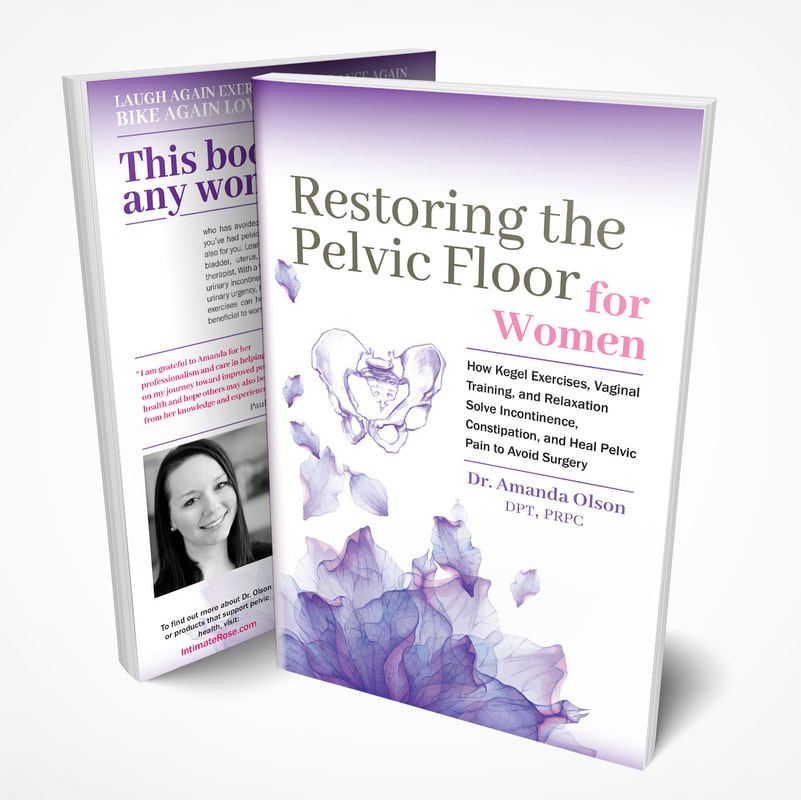|
This book is for any woman who has avoided the trampoline or yoga class for fear of urinary incontinence or pelvic organ prolapse. If you have pelvic pain, dyspareunia, vaginismus, vestibulodynia, vulvodynia, lichen sclerosis, endometriosis, androgen insensitivity syndrome (AIS), MRKH, or tailbone pain (coccydynia), this book is for you. If you suffer from constipation, urinary urgency, urinary frequency, or over active bladder, this book is also for you. Learn how to manage conditions related to the pelvic floor, bladder, uterus, and bowel from a certified pelvic floor physical therapist. With a tasteful sense of humor, and compassion, Dr. Olson explains how to cure urinary incontinence and pelvic organ prolapse using different types of Kegels, which foods and drinks to avoid for urinary urgency, and how to manage constipation.
The pelvic floor muscles are a vital system of muscles that support the pelvic organs (bladder, uterus, and rectum). These muscles can be too weak, too tight, or have poor co-ordination that can lead to issues with urination, defecation, pelvic pain, and intercourse. The good news is that these issues are solvable with natural remedies. Furthermore, learn how a pelvic physical therapist in your area can provide additional one on one help and specific kinds of treatment to address women’s health issues. If you are trying to find a natural way of curing common women’s health issues and avoid surgery, this book is for you. Find out how breathing, down training the pelvic floor, vaginal dilator training and specific pelvic exercises can help with pelvic pain. Pelvic exercises for beginners and more advanced exercises for progression are demonstrated, and most importantly which exercises are most beneficial to women’s health. Available on amazon at: http://clickmetertracking.com/RTPF Vaginismus, Vulvodynia, Vestibulodynia, Cancer Radiation, and Trauma: support for Vaginal pain5/9/2018 A recent British study analyzed the evidence behind abdominal hypopressive technique for the treatment of urinary incontinence (UI) and pelvic organ prolapse (POP).1 This technique has been gaining notoriety across fitness and physical therapy industries in Europe, Canada, South America, and more recently in the U.S. However, the study found no sound evidence supporting its use.
Abdominal Hypopressive Technique (AHT) utilizes the diaphragm by having the patient breathe deeply on inspiration and contracting the abdominal muscles after fully breathing out and holding the breath before relaxing. The theory posed by its founders is that the exercise involuntarily contracts the pelvic floor muscles through reduced intra-abdominal pressure, thereby reducing symptoms of UI and POP. Though AHT has been utilized in clinical practices for 20 years, the authors of the study note that no published evidence exists to support it. On the other hand, APTA SoWH Vice President Carrie Pagliano, PT, DPT is quoted in PT in Motion as saying, “There is some anecdotal, case-by-case support for this technique, and clinicians who use it in practice do identify hypopressives as a small component of treatment.”2 This sparks an interesting question as to how we lean on evidence versus anecdotal clinical reports. How do we analyze our knowledge of anatomy, physiology, and neuromotor control, and use that knowledge to determine which exercises are best for our patients? Evidence-informed and evidence-based clinical decision-making models are two hot topics now. Additionally, we as practitioners tend to use what we feel comfortable instructing, don’t we? |
AuthorAmanda Olson is a certified pelvic floor physical therapist, writer, and consultant. Archives
July 2020
Categories |

 RSS Feed
RSS Feed


